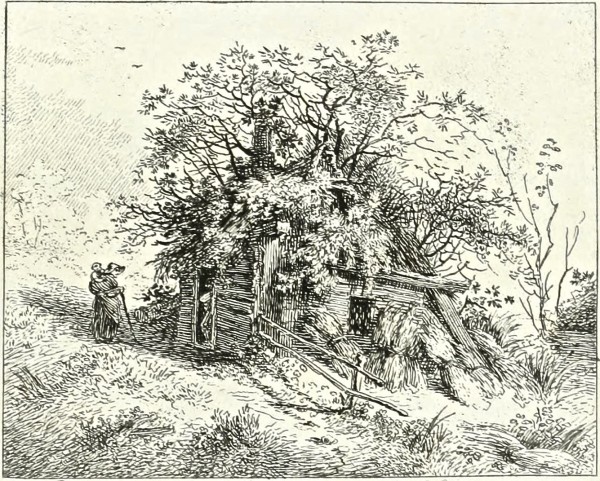John Thomas Smith’s Rural Cottages

Near Battlebridge, Middlesex
Once November closes in, I get the urge to go to ground, hiding myself away in some remote cabin and not straying from the fireside until spring shows. With this in mind, John Thomas Smith’s twenty etchings of extravagantly rustic cottages published as Remarks On Rural Scenery Of Various Features & Specific Beauties In Cottage Scenery in 1797 suit my autumnal fantasy ideally.
Born in the back of a Hackney carriage in 1766, Smith grew into an artist consumed by London, as his inspiration, his subject matter and his life. At first, he drew the old streets and buildings that were due for demolition at the turn of the eighteenth and nineteenth centuries in Ancient Topography of London and Antiquities of London, savouring every detail of their shambolic architecture with loving attention. Later, he turned his attention to London streetlife, the hawkers and the outcast poor, portrayed in Vagabondiana and Remarkable Beggars, creating lively and sympathetic portraits of those who scraped a living out of nothing but resourcefulness. By contrast, these rural cottages were a rare excursion into the bucolic world for Smith, although you only have to look at the locations to see that he did not travel too far from the capital to find them.
“Of all the pictoresque subjects, the English cottage seems to have obtained the least share of particular notice,” wrote Smith in his introduction to these plates, which included John Constable and William Blake among the subscribers, “Palaces, castles, churches, monastic ruins and ecclesiastical structures have been elaborately and very interestingly described with all their characteristic distinctions while the objects comprehended by the term ‘cottage scenery’ have by no means been honoured with equal attention.”
While emphasising that beauty was equally to be found in humble as well as in stately homes, Smith also understood the irony that a well-kept dwelling offered less picturesque subject matter than a derelict hovel. “I am, however, by no means cottage-mad,” he admitted, acknowledging the poverty of the living conditions, “But the unrepaired accidents of wind and rain offer far greater allurements to the painter’s eye, than more neat, regular or formal arrangements could possibly have done.”
Some of these pastoral dwellings were in places now absorbed into Central London and others in outlying villages that lie beneath suburbs today. Yet the paradox is that these etchings are the origin of the romantic image of the English country cottage which has occupied such a cherished position in the collective imagination ever since, and thus many of the suburban homes that have now obliterated these rural locations were designed to evoke this potent rural fantasy.

On Scotland Green, Ponder’s End

Near Deptford, Kent

At Clandon, Surrey – formerly the residence of Mr John Woolderidge, the Clandon Poet

In Bury St, Edmonton

Near Jack Straw’s Castle, Hampstead Heath

In Green St, Enfield Highway

Near Palmer’s Green, Edmonton

Near Ranelagh, Chelsea

In Green St, Enfield Highway

At Ponder’s End, Near Enfield

On Merrow Common, Surrey

At Cobham, Surrey – in the hop gardens

Near Bull’s Cross, Enfield

In Bury St, Edmonton

On Millbank, Westminster

Near Edmonton Church

Near Chelsea Bridge

In Green St, Enfield Highway

Lady Plomer’s Place on the summit of Hawke’s Bill Wood, Epping Forest

You may also like to take a look at these other works by John Thomas Smith
John Thomas Smith’s Ancient Topography of London
John Thomas Smith’s Antiquities of London
John Thomas Smith’s Vagabondiana
John Thomas Smith’s Vagabondiana II















Lovely. Some of them are almost like a hobbit hole (and I love hobbit holes).
What astonishing homes
Some of them look like they’re made up, they’re so handmade
Thank you for these incredible images and the story behind them. These early efforts in conservationism- even if only to preserve a knowledge of what was- is inspiring.
Good grief! Some of them look like my brother-in-law’s sheds which he cobbled together from bits of wood. He spends all his time plugging the leaks to preserve the contents. I wouldn’t want to try and live in one of them – insanitary, damp, insect infested, etc. These pictures show buildings which are picturesque but definitely slums. The rural slums were often worse than the spec housing erected in the industrial cities. They are interesting records of the rural dwellings that often existed in what are very urban areas now. A superb picture of how much has changed in 200 years.
Thank you for this post, and the one you wrote about the dead man of Clerkenwell on hallowe’en. I found them both very thought provoking and moving.
Fantastic detail – really fascinating.
Wonderful! Many thanks for sharing these.
These are some great pictures of old cottages. And I agree that their dilapidated state makes them look even more picturesque. The one in Deptford looks very unusual. And some others look like they could fall down at any moment.
Wonderfully evocative and areal delight.
I fancy the one shown as Cobham,Surrey by the hop gardens is more likely Cobham Kent.